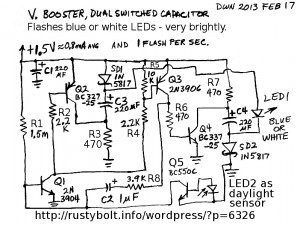 I named this “Blinky Booster” dual switched capacitor voltage boost flasher after my Blue Blinky, which used a coil. This dual switched capacitor voltage boost flasher uses no coil or inductor. Last week I got Bowden’s flasher, a single switched capacitor voltage boost flasher, working properly, but it was not capable of flashing blue or white LEDs. The dual switched capacitors put twice as much voltage boost out to the LED, so it’s capable of flashing white or blue LEDs. Bowden’s flasher used resistors to supply current to the switched capacitor, this one uses two Schottky diodes to block the reverse current when the capacitors are switched. These two 1N5817 Schottky diodes are a lot more expensive than two resistors, but they help reduce losses and improve the performance. If cost is a factor, the resistors could be used instead. It might be possible to use the 1N4148 cheapo diodes, but I haven’t tried it yet.
I named this “Blinky Booster” dual switched capacitor voltage boost flasher after my Blue Blinky, which used a coil. This dual switched capacitor voltage boost flasher uses no coil or inductor. Last week I got Bowden’s flasher, a single switched capacitor voltage boost flasher, working properly, but it was not capable of flashing blue or white LEDs. The dual switched capacitors put twice as much voltage boost out to the LED, so it’s capable of flashing white or blue LEDs. Bowden’s flasher used resistors to supply current to the switched capacitor, this one uses two Schottky diodes to block the reverse current when the capacitors are switched. These two 1N5817 Schottky diodes are a lot more expensive than two resistors, but they help reduce losses and improve the performance. If cost is a factor, the resistors could be used instead. It might be possible to use the 1N4148 cheapo diodes, but I haven’t tried it yet.
Why Not A Joule Thief?
 What are the advantages and disadvantages of this circuit compared to a Joule Thief? It’s hard to beat the simplicity of a Joule Thief – it’s obvious from looking at the schematic that this is more complex- four or five times as many parts. It’s probably more costly, too, but that depends on how much the JT coil costs. That is one advantage: it doesn’t use a coil, so no coil to wind, or to try to obtain already wound. Another advantage is that since it doesn’t use a coil, there are no electromagnetic fields generated so electromagnetic interference and radio frequency interference are minimal if not absent. Another advantage is that this circuit uses the R1 and C2 to control the pulse frequency, and R8 to control the pulse width. This allows those to be adjusted with little interaction. The Joule Thief is so simple that the pulse width and frequency are ‘intertwingled’, where trying to change one makes the other change.
What are the advantages and disadvantages of this circuit compared to a Joule Thief? It’s hard to beat the simplicity of a Joule Thief – it’s obvious from looking at the schematic that this is more complex- four or five times as many parts. It’s probably more costly, too, but that depends on how much the JT coil costs. That is one advantage: it doesn’t use a coil, so no coil to wind, or to try to obtain already wound. Another advantage is that since it doesn’t use a coil, there are no electromagnetic fields generated so electromagnetic interference and radio frequency interference are minimal if not absent. Another advantage is that this circuit uses the R1 and C2 to control the pulse frequency, and R8 to control the pulse width. This allows those to be adjusted with little interaction. The Joule Thief is so simple that the pulse width and frequency are ‘intertwingled’, where trying to change one makes the other change.
Another disadvantage is that the voltage boost depends on the supply, so the flash dims rapidly when the battery voltage drops down to 1 volt and is completely gone below 0.9V. But the very low current drain – 0.8 milliamps average – means that it will take a long time to deplete a fresh cell; probably months. I’m not sure what the capacity of an alkaline AA cell is, but if it is 2000 mA-h, then the cell should last for 2500 hours, which is close to 15 weeks. But that’s running 24/7; if the daylight sensor turns it off half the time, then it will be close to 30 weeks or more than 6 months.
That’s another point about this circuit: the daylight sensor. It uses any color LED (red is probably cheaper) as a daylight sensor. The LED’s feeble current is amplified by Q5 which shunts the current from the 1.5 meg to negative. It would not be possible to use a CdS photocell or LDR here because the smallest amount of light on it would reduce its resistance to much less than the 1.5 Megohm resistor. But the LED aka LSD and Q5 work just fine. When the whole circuit is turned off, there is minimal current draw from the battery. I have not yet added the daylight sensor to the circuit because I anticipated that the circuit would need a lot of work (the Bowden circuit took a lot of my time), so I wanted solve any problems before adding the daylight sensor later. But to test it, I shorted the base of Q1 to the emitter, and the supply current was less than 1.5 microamps; that amounts to the current through R1 and no current in the rest of the circuit. And 1.5 microamps is essentially no load to the battery so it will last its shelf life. I have not tried to add a daylight sensor to the Joule Thief flasher, but it would add several more parts to the circuit.
The bottom line here is: Would I use this circuit instead of a Joule Thief Flasher? If the low battery current, long cell life and bright flash of a blue or white LED were the higher priority, then the answer would be yes. Otherwise, the simplicity, and cheapness of the Joule Thief Flasher would be a better choice.
Update Feb 21 – I built a second circuit. I used the first one above as the template and eyeballed the locations of the holes on the blank board and drilled the holes. I clamped two blanks together and drilled both at the same time, so I have a third board to use either as another circuit, or else as the master template to drill more boards. On the first board, I had a few tight places because it was the ‘prototype’ board; I couldn’t foresee what was going where. On these second and third boards, the components will be more properly positioned, knowing what I know after building the first board.
I powered this second board up, and it flashed erratically and a bit fast. I measured the voltage on the board and it was dropping down the below 1.35 volts. The contacts on the battery were apparently causing the problem. When I removed one of the magnets, its end was covered with green corrosion. I scraped it off and the erratic fast flash disappeared. When the flasher draws heavy current during the on time, it puts a high current demand on the cell. If there’s just a slight amount of resistance in the contacts or wiring, it shows up as a drop in cell voltage. Clean contacts and good soldering joints take care of the problem.
Back to experimenting…
Take a look at this schematic:
http://www.zea.jp/audio/ledt/ledt_01.htm
The page is in japanese, use the google translator.
Thank you for the link. That is a switched capacitor or flying capacitor circuit. It is similar to the ones on Cappels web page.